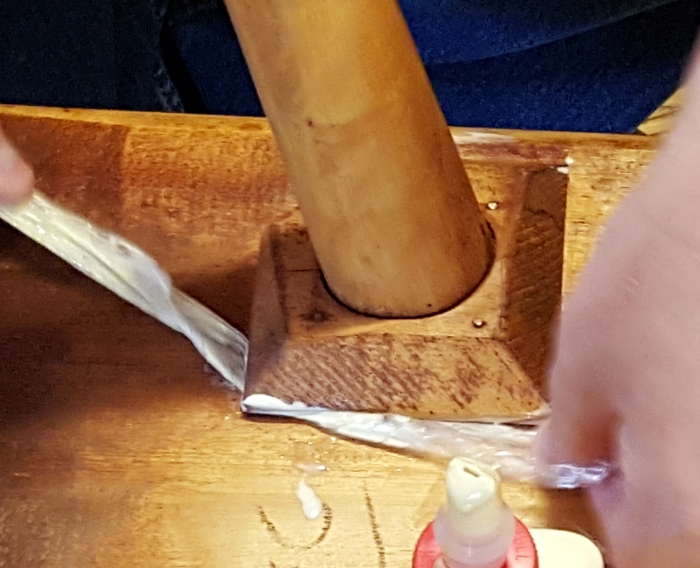| | 11/25/2015 |  In the early 1950's my parents bought a modern, Danish style set of table and chairs that fit quite well in the dining area of the tenement apartment where I grew up until age 11. This is when Danish furniture was something new and exciting and Ikea did not exist. The table is long gone, given away to a cousin, and eventually discarded. But the chairs I have always liked and over the past twenty years, all but one of the set of six have migrated to my apartment. In the early 1950's my parents bought a modern, Danish style set of table and chairs that fit quite well in the dining area of the tenement apartment where I grew up until age 11. This is when Danish furniture was something new and exciting and Ikea did not exist. The table is long gone, given away to a cousin, and eventually discarded. But the chairs I have always liked and over the past twenty years, all but one of the set of six have migrated to my apartment.
The newsworthy bit of all of this is that after 60 years the glue that holds the legs on is starting to fail and several legs have collapsed, requiring a repair. The legs are threaded and screwed into threaded holes int he chair bottom. To add some thickness wooden pads build up the thickness around the leg sockets. The pads were simply glued on with four small nails to keep them steady while the glue dried. Wood movement over the years have caused the pads to crack and the glue, which was originally poorly and spottily applied, has given way on many chairs, causing the leg to fail. If the leg comes completely off, what I do is clean off the glue, and reglue the pad and leg on. This seems to work. But on some legs the pad has begun to give way but isn't exactly off, and the leg cannot be just unscrewed. My solution, which is really just a patch, is to force glue into the joint, apply a little pressure and then hope it all sticks. The glue being stronger than the wood.
Many years ago I learned this trick Maurice Fraser to force the glue deep into the joint (which is critical). Ideally you use a piece of cellophane wrapper from a pack of cigarettes (preferably Will's Gold Flake). It's thin and rigid. Sadly I don't smoke so I didn't have any cellophane but I did have a lot of plastic wrap. This didn't work as well but it worked pretty well. You have to be careful as the plastic wrap bunches up as you slide it in and out of the joint. What you do is apply a lot of glue on the outside of the joint and then try to slide a single layer of plastic in and out of the joint pushing and spreading the glue into the joint. Then clamp or squeeze shut the joint and let the glue dry. It works pretty well. Not as well as being able to take apart the joint and cleaning and preparing fresh surfaces, but it's better than nothing. This is a handy trick to use on any glue starved joint where fully dissembling the item is impractical.
I used yellow glue, another option would be Old Brown, which now that i think of it might be stronger, and of course Old Brown is reversible.
A Happy and Healthy Thanksgiving! to everyone and their families. For those looking for a Cyber Monday sale we do plan to discount some of our discontinued products that we have lying around. The sale won't be as big as last years but it will have some nice stuff in it.
In other news, and I will have more about this at another time, we will be moving soon. We don't know where and if you know of (or know someone who knows of) a ground or second floor rental in Brooklyn that isn't outrageous that might work for some toolmaking and a showroom please give us a ring. We might be moving our warehouse upstate, so any good leads in that direction would also be appreciated.
| Join the conversation | |
| The opinions expressed in this blog are those of the blog's author and guests and in no way reflect the views of Tools for Working Wood. |
|
 Joel's Blog
Joel's Blog Built-It Blog
Built-It Blog Video Roundup
Video Roundup Classes & Events
Classes & Events Work Magazine
Work Magazine


 In the early 1950's my parents bought a modern, Danish style set of table and chairs that fit quite well in the dining area of the tenement apartment where I grew up until age 11. This is when Danish furniture was something new and exciting and Ikea did not exist. The table is long gone, given away to a cousin, and eventually discarded. But the chairs I have always liked and over the past twenty years, all but one of the set of six have migrated to my apartment.
In the early 1950's my parents bought a modern, Danish style set of table and chairs that fit quite well in the dining area of the tenement apartment where I grew up until age 11. This is when Danish furniture was something new and exciting and Ikea did not exist. The table is long gone, given away to a cousin, and eventually discarded. But the chairs I have always liked and over the past twenty years, all but one of the set of six have migrated to my apartment.
Enjoy Thanksgiving!
I have found that the fuzzy type of dental floss works well and if it gets stuck you can pull it out from the end. Also pulling it out from the end prevents pulling out glue. Another good tool are the plastic toothpicks with a fuzzy brush on one end